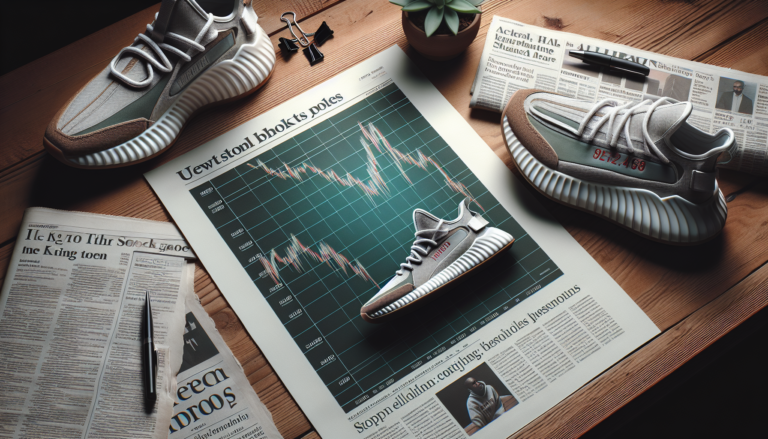Introduction to Nike’s Recent Stock Decline
Nike, the iconic sportswear giant, recently experienced a significant decline in its stock price, marking one of the worst days in the company’s 44-year public history. The stock plummeted by 20%, wiping out $28 billion in market value and leaving investors stunned. This sharp drop has raised questions about the factors contributing to Nike’s financial woes and the potential implications for the company’s future.
Overview of the Stock Drop
On September 30, 2022, Nike’s stock price hit a 4-year low, with shares trading at around $82.50. This marked a staggering 20% decline from the previous day’s closing price, resulting in a market capitalization loss of approximately $28 billion. The sudden plunge sent shockwaves through the investment community, as Nike had long been considered a stable and reliable performer in the sportswear industry.
The magnitude of the drop was particularly striking, as it represented the worst single-day decline in Nike’s history as a publicly traded company. Investors were left grappling with the reasons behind this sudden downturn and the potential long-term consequences for the brand.
Historical Context of Nike’s Stock Performance
To fully comprehend the significance of Nike’s recent stock decline, it is essential to consider the company’s historical performance. Over the years, Nike has established itself as a dominant force in the global sportswear market, consistently delivering strong financial results and maintaining a loyal customer base.
However, the company has not been immune to market fluctuations and economic challenges. In the past, Nike has faced obstacles such as increased competition, changing consumer preferences, and global economic uncertainties. Despite these hurdles, the company has generally managed to adapt and maintain its position as a leader in the industry.
The recent stock drop, however, has raised concerns among investors and analysts about the severity of the current challenges facing Nike and the company’s ability to navigate these difficulties in the short and long term.
Factors Contributing to the Decline
Several key factors have contributed to Nike’s recent stock decline, ranging from disappointing financial results to increased market competition and changing consumer preferences.
Impact of the Earnings Report
One of the primary triggers for the stock drop was Nike’s disappointing earnings report. The company reported a 2% decline in quarterly sales and forecasted a 10% year-over-year decrease in revenue. These numbers fell short of analysts’ expectations and raised concerns about Nike’s ability to maintain its growth trajectory.
The earnings report also revealed weaknesses in Nike’s direct-to-consumer strategy, which had been a key focus for the company in recent years. The underwhelming performance in this area further compounded investor concerns about Nike’s overall financial health.
Challenges in the China Market
Nike’s slumping business in China has also played a significant role in the stock decline. China has been a crucial market for Nike, accounting for a substantial portion of its global sales. However, the company has faced challenges in the region, including increased competition from local brands and changing consumer preferences.
The COVID-19 pandemic has further exacerbated these issues, leading to supply chain disruptions and reduced consumer spending. Nike’s inability to effectively navigate these challenges in China has contributed to the company’s overall financial struggles.
Increased Market Competition
Nike is facing intensified competition from rival brands such as Alo, Hoka, Adidas, and New Balance. These competitors have been gaining market share and attracting consumers with innovative products and compelling marketing strategies.
The increased competition has put pressure on Nike to differentiate itself and maintain its position as a leader in the sportswear industry. The company’s failure to effectively respond to these competitive threats has contributed to its declining stock performance.
Consumer Preferences and Trends
Changing consumer preferences and trends have also played a role in Nike’s stock decline. Global search volumes for Nike products have decreased by 10%, indicating a reduced interest among consumers.
Younger generations, in particular, are gravitating towards newer, trendier brands that align with their values and lifestyles. Nike’s perceived lack of innovation and failure to keep pace with evolving consumer demands has contributed to its declining market position.
Investor Sentiment and Market Reactions
The stock decline has had a significant impact on investor sentiment and market perceptions of Nike’s future prospects.
Analyst Downgrades and Market Perception
Following the disappointing earnings report and stock drop, several analysts downgraded Nike’s rating from “buy” to “neutral.” These downgrades reflect a growing concern among market experts about the company’s ability to rebound from its current challenges.
The negative sentiment surrounding Nike has further contributed to the stock’s decline, as investors become increasingly cautious about the company’s future performance. The market’s perception of Nike as a stable and reliable investment has been shaken, leading to a broader sell-off of the company’s shares.
Impact of the Class Action Lawsuit
In addition to the financial challenges, Nike is also facing a class action lawsuit alleging misleading statements regarding its direct-to-consumer strategy. The lawsuit claims that Nike made false and misleading statements about the strength of its DTC business, which has been a key area of focus for the company.
The legal proceedings have further eroded investor confidence in Nike’s management and overall business strategy. The uncertainty surrounding the outcome of the lawsuit has added to the negative sentiment surrounding the company.
Management and Leadership Issues
Investor dissatisfaction with Nike’s performance has also been directed towards the company’s management, particularly CEO John Donahoe. Since taking the helm in January 2020, Donahoe has overseen significant restructuring efforts and strategic shifts within the company.
However, the recent financial struggles and stock decline have raised questions about the effectiveness of Donahoe’s leadership and his ability to steer Nike through its current challenges. Dismal earnings calls and perceived mismanagement have further eroded investor confidence in the company’s leadership.
Financial Metrics and Valuation
The stock decline has had a profound impact on Nike’s financial metrics and overall valuation.
Market Capitalization and Valuation Trends
Nike’s market capitalization, which represents the total value of the company’s outstanding shares, has taken a significant hit due to the stock drop. The company lost approximately $28 billion in market value in a single day, highlighting the severity of the decline.
The reduction in market capitalization reflects a broader trend of declining investor confidence in Nike’s future prospects. As the stock price continues to languish, the company’s overall valuation has come under increased scrutiny.
Price-to-Sales Ratio Analysis
One key metric used to assess a company’s valuation is the price-to-sales (P/S) ratio, which compares the stock price to the company’s revenue. Nike’s P/S ratio has fallen to its lowest level since 2013, indicating that investors are placing a lower value on the company’s sales.
The decline in the P/S ratio suggests that investors are concerned about Nike’s ability to generate future revenue growth and maintain its market position. This pessimistic outlook has contributed to the overall decline in the company’s stock price and valuation.
Future Outlook and Recovery Strategies
Despite the current challenges, there are potential opportunities for Nike to recover and regain its footing in the market.
Potential for Recovery in Upcoming Events
One potential catalyst for Nike’s recovery is the upcoming Paris Olympics in 2024. As a major sponsor and provider of athletic gear, Nike has historically benefited from increased exposure and sales during Olympic years.
The Paris Olympics could provide a platform for Nike to showcase its latest innovations, connect with consumers, and reignite interest in its brand. A strong performance during the Olympics could help boost investor confidence and drive a rebound in the company’s stock price.
Long-term Investment Strategies
For long-term investors, the current decline in Nike’s stock price may present an opportunity to acquire shares at a discounted value. However, it is important to recognize that the company’s recovery may not be immediate and could be influenced by various market factors and economic conditions.
Investors considering a long-term position in Nike should carefully evaluate the company’s fundamentals, competitive position, and ability to adapt to changing consumer preferences. A well-diversified investment strategy that takes into account the potential risks and rewards of investing in Nike is essential.
Conclusion
Nike’s recent stock decline has sent shockwaves through the investment community and raised concerns about the company’s future prospects.
Summary of Key Points
The stock drop, which saw Nike lose $28 billion in market value, can be attributed to several key factors:
- Disappointing earnings report and declining sales
- Challenges in the crucial China market
- Increased competition from rival brands
- Changing consumer preferences and reduced interest in Nike products
The decline has also been exacerbated by investor dissatisfaction with Nike’s management, particularly CEO John Donahoe, and the impact of a class action lawsuit alleging misleading statements.
Final Thoughts on Nike’s Stock Performance
While the current challenges facing Nike are significant, the company’s long-term prospects remain uncertain. The ability to recover and regain its position as a market leader will depend on Nike’s capacity to adapt to changing market conditions, innovate its product offerings, and effectively navigate the competitive landscape.
Investors considering Nike as a long-term investment should carefully weigh the potential risks and rewards, taking into account the company’s fundamentals, market position, and ability to execute its strategic initiatives. As with any investment, a well-diversified portfolio and a thorough understanding of the underlying factors driving Nike’s performance are essential.
See also:






